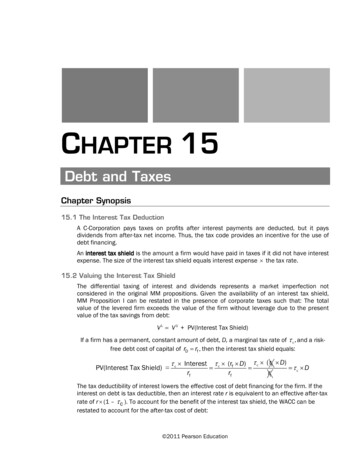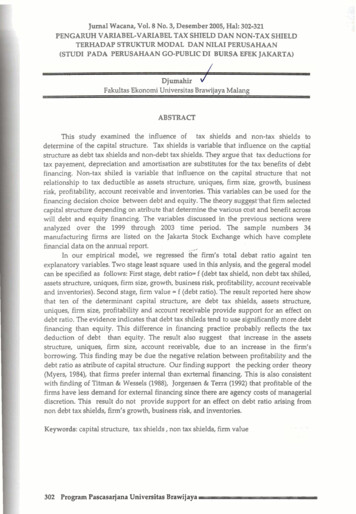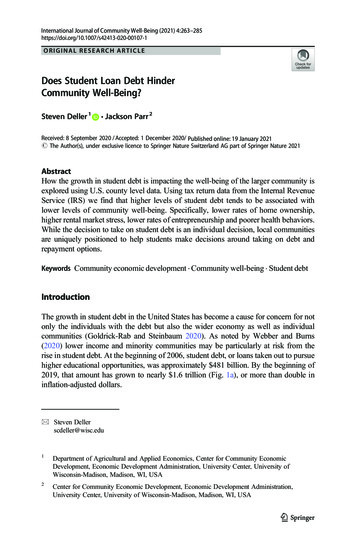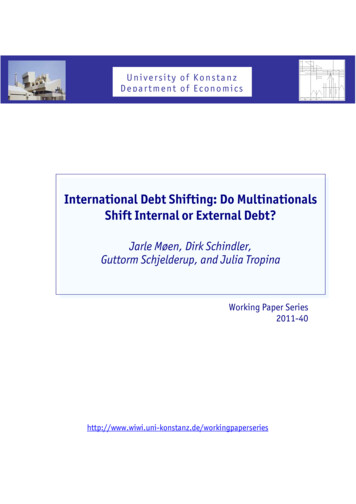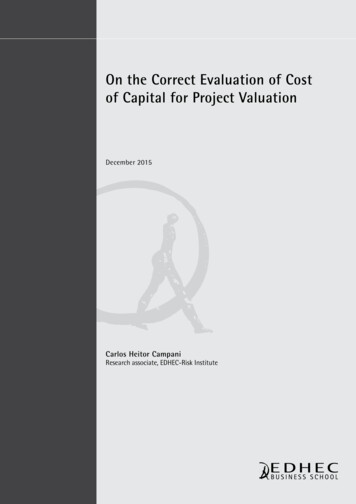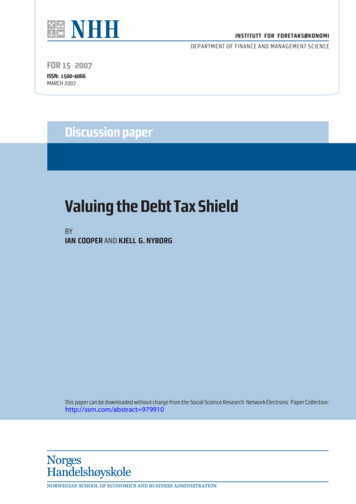
Transcription
INSTITUTT FOR FORETAKSØKONOMIDEPARTMENT OF FINANCE AND MANAGEMENT SCIENCEFOR 15 2007ISSN: 1500-4066MARCH 2007Discussion paperValuing the Debt Tax ShieldBYIAN COOPER AND KJELL G. NYBORGThis paper can be downloaded without charge from the Social Science Research Network Electronic Paper Collection:http://ssrn.com/abstract 979910
VALUING THE DEBT TAX SHIELDIan Cooper, London Business School, and Kjell G. Nyborg, Norwegian School ofEconomics and Business Administration and CEPR 1EXECUTIVE SUMMARYThe tax shield from debt represents a significant proportion of total value formany companies, projects, and transactions. Accurate valuation of the debt tax shield is ofmore importance than ever as leverage is now commonly used as a source of value added,and there is growing competition in buying assets. Changes in tax rules and moreinternational transactions also make it important to understand how to value debt taxshields under different tax regimes.The increased practical importance of accurate valuation of the debt tax shield hasbeen paralleled by debates among researchers about how to do it. The differentapproaches have large effects on estimated values. In this article, we review theseapproaches and show their implications for practical debt tax shield valuation. The issuewe stress is that each method relies on a few basic assumptions, primarily about the riskof debt tax shields. Picking the most appropriate assumption in any particular situationand then using only those procedures that are consistent with that assumption is the key togood valuation of debt tax shields. Using inconsistent procedures can lead to large errors.The structure of the article is as follows: We start by giving a brief overview ofthe theory. Then we review the tensions that exist in the “how to value tax shields”literature. Next, we discuss the practical implications of the various approaches and showby way of an example the large errors that can arise if incorrect and inconsistent valuation1Cooper: London Business School, Regent’s Park, London NW1 4SA, UK. Email:icooper@london.eduNyborg: Norwegian School of Economics and Business Administration, Helleveien 30, 5045 Bergen,Norway. Email: kjell.nyborg@nhh.noPage 1
methods are used. Finally, we offer our views as to which methods and assumptions aremost appropriate in various real world economic settings.INTRODUCTIONThe tax shield from debt represents a significant proportion of total value formany companies, projects, and transactions. Its potential size can be seen by consideringa company with a 30% debt-to-capital ratio and a corporate tax rate of 40%. Oneapproach to valuing the debt tax shield is simply to multiply the amount of debt by the taxrate, in which case the debt tax shield would be seen as contributing 12% of total value.And if the leverage ratio were doubled, the debt tax shield could be shown to contributealmost a quarter of the value of the company.Three developments have increased the importance of accurate valuation of thedebt tax shield in recent years. First, to a greater extent than in any period since therestructurings of the 1980s, leverage is commonly used as a potential source of valueadded in investment decisions. Second, growing competition in buying assets means thataccuracy in valuation can give potential buyers a competitive edge in many transactions.Finally, changes in tax rules, such as those brought about by the Bush tax cut of 2003,along with the rising frequency of international transactions, make it important tounderstand how to value debt tax shields under different tax regimes.The rise in the importance of accurate valuation of the debt tax shield has beenparalleled by debates among researchers about how to do it. Among the issues beingdebated are the following:-Does the value of the debt tax shield reflect the full corporate tax rate or a lowerrate?-Does the value of the tax shield differ in tax regimes that favor dividends?Page 2
-Should you value the tax shield by using adjusted present values or by adjustingthe discount rate?-If you use adjusted present value, how should you obtain the discount rate?-What formula should be used for the present value of the tax shield?These debates have considerable practical importance. As we show later, how theseissues get decided can have large effects on the estimated value of the debt tax shield.In this article, we review these debates and show their implications for debt taxshield valuation. First, we give a brief overview of the theory. Then we review thetensions that exist in the “how to value tax shields” literature. Next, we discuss thepractical implications of the various approaches. Finally, we offer our views as to whichmethods and assumptions are most appropriate in various real world economic settings,along with an example that illustrates the likely consequences of choosing a givenapproach.Before embarking on the review, we emphasize that the issues we discuss here aredifferent from the familiar debates about optimal capital structure. The question of howto value the debt tax shield is important, regardless of one’s view of the valuemaximizing leverage ratio. The two issues are related in the sense that both depend onjudgments about the value of the tax saving from debt. However, anyone involved invaluation needs to decide how to value debt tax shields, regardless of their view ofoptimal capital structure. In this article, we discuss how to value the tax shield given acompany’s chosen debt policy; we do not address whether this policy is optimal or what avalue-maximizing policy would be. 2Page 3
OVERVIEW OF THEORYAll valuations that attempt to capture the value of the tax savings from interest canbe represented by the following adjusted present value (APV) formula:VL E D VU PVTS,(1)where VL is the value of the levered company (the firm’s “enterprise value,” as it is oftencalled); E is the market value of equity; D is the market value of debt, VU is the value ofthe same company without any leverage (the unlevered company); and PVTS is thepresent value of the tax saving from debt.To use the APV approach, however, one must first calculate the firm’s unleveredvalue. This means discounting the firm’s operating free cash flow at the “unlevered”discount rate, and then making a separate calculation of the present value of the debt taxshield. The operating free cash flow is the cash flow after tax but before interest. Allother standard methods for including the debt tax shield in valuation are derived from theAPV equation. Although they appear different, their results will be consistent with thoseprovided by APV, as long as one can satisfy a particular set of assumptions in each case.The two most commonly used methods for valuing debt shields are the WACCapproach and the capital cash flow approach. The WACC approach estimates the firm’slevered value (VL) directly by discounting its operating free cash flow at the weightedaverage cost of capital (WACC). In contrast to the APV approach, this methodeffectively captures the value of the debt tax shield in the (lower) discount rate, and not asa separate component of value. The capital cash flow approach discounts the sum ofoperating free cash flow and the tax saving from interest at the unlevered cost of capital(which is higher than WACC). This method puts the adjustment for the debt tax shield2An excellent review of the broader issues can be found in John Graham, “Taxes and Corporate Finance: AReview,” Review of Financial Studies, Vol. 16 (2003), pp. 1075-1129.Page 4
into the cash flows rather than making it a separate component of value or including it inthe discount rate. 3Review of cash flow definitionsOperating free cash flow (FCF):Free cash flow after tax, assuming that the company is financed entirely with equity. Thisis net of capex and tax, but not depreciation and interest. The tax is calculated without theinterest tax deduction.Capital cash flow (CCF):Free cash flow available to the combination of debt and equity holders.The relationship:CCF FCF Tax saved from interestIf the APV approach is used, one way of calculating the present value of the taxshield, PVTS, is to multiply the corporate tax rate, TC, by the market value of debt:PVTS TCD(2)But use of this formula is based on two strong assumptions: (1) the company is expectedto be profitable enough to pay the full corporate tax rate every year in perpetuity; and (2)the amount of debt is fixed (forever) at the level D. This approach is sometimes calledthe Miller-Modigliani (M&M) approach because it was first developed by Merton Millerand Franco Modigliani in a 1963 paper. 4 The use of the M&M formula, (2), for the debttax shield is a special case of the APV approach that makes somewhat restrictiveassumptions about the level and risk of the debt tax shield. In particular, use of thisapproach effectively assumes that the company is not expected to grow, which of courselimits its range of application in ways that we discuss later.Use of the WACC and capital cash flow approaches are based on somewhatdifferent assumptions about the company’s expected future tax status and debt policy-3A detailed explanation of the capital cash flow approach is provided by Richard Ruback in his article,“Capital Cash Flows: A Simple Approach to Valuing Risky Cash Flows,” Financial Management Vol. 31(2002) pp. 85-103.Page 5
assumptions that, as we will show, affect the level and risk of the future tax saving frominterest and hence the value of the debt tax shield. The WACC approach assumes thatdebt is a constant proportion of company value instead of the fixed amount of debtassumed by M&M. 5 Given this assumption, the WACC approach involves calculatingthe weighted average cost of capital as follows:WACC (E/VL)*KE (D/ VL)*KD*(1-TC),(3)where KE is the cost of equity and KD is the cost of debt. The operating free cash flow ofthe company is discounted at the WACC to estimate directly the value of the leveragedcompany (VL), which includes the value of the debt tax shields. As mentioned earlier, theWACC approach effectively incorporates the value of the debt tax shield through use of alower discount rate. By so doing, the WACC method estimates the value of the leveredcompany in a one-step valuation, rather than separately estimating the unlevered valueand the present value of debt tax shields. As we show later, this approach implies aparticular value for PVTS but does not explicitly calculate it.The capital cash flow approach assumes that the risk of the interest tax shield isthe same as the risk of the operating free cash flow. This can arise for two reasons. One isbecause the amount of debt and interest will be proportional to the future value of thecompany. This is the assumption that underlies the WACC approach, and is best dealtwith using that method. The other reason, which the proponents of the capital cash flowapproach use as a justification, is that the future tax savings from interest depend on thelevel of future operating income. If the company may not have enough operating incometo pay tax, then interest cannot be used to save tax immediately. In this case, the risk of4Franco Modigliani and Merton Miller “Corporate Income Taxes and the Cost of Capital: A Correction”American Economic Review Vol. 53 (1963), pp. 433-443.5This is sometimes called the Miles-Ezzell approach because they were the first to show the relationshipbetween valuation using the WACC and the capital structure assumption of constant proportional leverage.See James Miles and John Ezzell,“The Weighed Average Cost of Capital, Perfect Capital Markets, andProject Life: A Clarification,” Journal of Financial and Quantitative Analysis Vol. 15 (1980), pp. 719-730.Page 6
the interest tax savings from debt will be higher than the risk of the interest charges. Forsuch cases, the assumption that the risk of the interest tax savings is equal to the risk ofthe operating cash flows is advocated as a simple approximation.With this assumption, the tax savings from interest and the operating free cashflows have the same levels of risk and can be combined into a single measure calledcapital cash flow. As already noted, this should be discounted at the unlevered cost ofcapital. The resulting present value is an estimate of the levered value because the debttax shield has been included in the cash flows.To sum up, then, there are three methods of incorporating the debt tax shield intoa valuation:Method 1: APV: Discount the operating free cash flow at KU to give VU. AddPVTS to give VL.Method 2: WACC: Discount the operating free cash at WACC to give VL.Method 3: Capital cash flow: Discount the capital cash flow at KU to give VL.The most general of these is the APV method; it can accommodate any assumption aboutthe debt policy of the company and the risk of debt tax shields. But even if the APVmethod is used, the choice of a particular method of estimating the unlevered discountrate implies a particular debt policy, and the use of a particular formula for PVTS alsoimplies a particular debt policy. For example, the use of M&M formula (2) implies verystrong assumptions about debt policy. Like use of the WACC method, it assumes thatdebt is a constant proportion of value. The capital cash flow method assumes that debttax shields have the same level of risk as the operations of the company. The importantpoint here is that given the appropriate assumptions, one can calculate the leveraged valueof the company using either of these two methods in a way that is consistent with thebasic APV formula.Page 7
The tax treatment of investors. Each of the three approaches discussed so farassumes that the present value of a dollar of tax saved by the company is fully reflected inshareholder value. But, in addition to arguments about the validity of each of thesemethods, there is also some disagreement as to whether the tax rate that should be used incalculating the value of the debt tax shield should be lower than the corporate tax ratebecause of taxes incurred by investors. The standard way to deal with this issue has beento define a net tax saving variable, T*, that reflects the tax treatment of the investors whohold the company’s debt and equity as follows:(1-T*) (1-TC)[(1-TPE)/(1-TPD)],(4)where TPE is the marginal tax rate of the investors who determine the company’s cost ofequity, and TPD is the tax rate at the margin of the investors who determine the company’scost of debt.As can be seen from this equation, if the tax treatment of debt and equity is thesame, then the net tax saving variable, T*, is equal to the full corporate tax rate, and allthe valuation formulas discussed above apply. But if the tax treatment of equity is morefavorable than the tax treatment of debt, then T* will be lower than the full corporate taxrate and the valuation formulas should be adjusted accordingly. Specifically, the value ofthe debt tax shield should be calculated using the lower net tax saving rate, rather than thefull corporate tax rate. For instance, in that case equation (2) should be:PVTS T*D,(5)which yields a lower value for the debt tax shield. A value of T* lower than the corporatetax rate would also affect the calculation of the cost of capital, which we discuss below.This completes our brief review of the theory. We now summarize several debatesamong researchers that are relevant to the practical valuation of debt tax shields. ThesePage 8
concern the size of the net tax saving, T*, and what formulas to use when valuing the debttax shield.DEBATES ABOUT THE SIZE OF T*Debate 1: How big was the value of debt tax shields in the U.S. prior to 2003?Because the investor tax rates that enter the expression for T* cannot be observeddirectly, the debate as to whether investor taxes reduce the value of the debt tax shield isan empirical one. The only studies that provide explicit estimates of T* are based onregressions of the value of levered companies on their amounts of debt, while controllingfor other variables that are assumed to affect their unlevered values. 6These regressions involve considerable econometric difficulties because thecontrols for the unlevered value are difficult to implement. However, the mostsophisticated test for the U.S. to date, by Deen Kemsley and Doron Nissim, finds that thevalue of T* for the U.S. prior to the 2003 tax changes was close to the then full corporatetax rate of 40%. Thus the best evidence concludes that, in a classical tax system wheretaxes on dividends and interest are the same, T* is roughly equal to TC. So the empiricalevidence suggests that standard methods of valuing the debt tax shield are correct under aclassical tax system.Debate 2: Is the value of the debt tax shield lower in tax systems that favordividends?The evidence just cited concerned the U.S. prior to 2003, with its classical taxsystem in which dividends and interest were taxed at the same rate. In the U.S. since2003, and in many countries with “imputation” tax systems as well, the investor tax on6Two important papers are Eugene Fama and Kenneth French, “Taxes, Financing and Company Value,”Journal of Finance, Vol. 53 (1998), pp. 819-843; and Deen Kemsley and Doron Nissim, “Valuation of theDebt Tax Shield,” Journal of Finance Vol. 57 (2002), pp. 2045-2073. The latter paper corrects aneconometric problem in the former.Page 9
dividends is lower than the investor tax on interest. The U.S. tax system now has a lowertax rate for dividends than for interest, and imputation systems have the same effect byallowing investors to claim back part of the corporate tax when dividends are distributed.This creates the possibility that T* may be lower than TC because the tax treatment ofequity returns is more favorable than the tax treatment of interest for the same investor.There have been several attempts to test whether the value of the debt tax shield issmaller in countries with tax systems that favor equity over debt. Equation (4) says thatwhen the equity tax rate is lower than the tax rate on interest, the net tax saving, T*, issmaller than the corporate tax rate. There are some indirect indications that this may bethe case in tax systems that favor dividends. Evidence from the U.K. before and after itsswitch from an imputation system to a classical tax system in 1997 shows that the tax rateon dividends implied by ex-dividend day share price moves was lower when dividendshad a favored tax treatment. 7 Evidence from the U.S. since the Bush tax cut of 2003suggests that dividends have increased as a result of that change, as would be expected iftheir more favorable tax treatment increased their value and reduced the relative value ofthe debt tax saving. 8Such indirect evidence suggests that leverage may be less valuable in tax systemsthat favor dividends, but does not provide evidence on the value of T* that should be usedin valuations. In some cases where the tax system currently favors dividends overinterest, such as the U.S. at the present time, that tax regime may not be expected tocontinue. Valuing the debt tax shield for a company involves predicting the net taxsaving from interest for the indefinite future. The use of a net tax saving significantly lessthan the full corporate tax rate requires that the tax system favor equity returns--for7Leonie Bell and Tim Jenkinson, “New Evidence of the Impact of Dividend Taxation and on the Identity ofthe Marginal Investor,” Journal of Finance, Vol. 57 (2002), pp. 1321-1346.8Brandon Julio and David Ikenberry, “Reappearing Dividends,” Journal of Applied Corporate Finance Vol.16 (2004), pp. 89-100.Page 10
example, due to a lower tax on dividends than interest--and that this be expected tocontinue. The one case where this clearly applies is in those countries that have hadimputation tax systems for a long time, such as Australia, France, and Germany. Thiswas also the case in the U.K. prior to the unexpected change in the tax system in 1997.We discuss later how to incorporate imputation taxes into valuations.Debate 3: Is T* lower for some companies and transactions?Even in classical tax regimes that do not favor dividends over interest, such as theU.S. prior to 2003, there will be companies or transactions for which the debt tax shieldhas lower value because there is not enough taxable income to use the full interest taxdeduction to save taxes. In such cases, the estimate of the value of the debt tax shieldshould be the present value of the actual taxes expected to be saved, an amount that willbe less than the interest charge multiplied by the corporate tax rate. One way to includethis in the valuation is to estimate the expected tax saving from interest using a methodsuch as simulation. 9 An alternative is to use the capital cash flow method, which assumesthat the tax saving has the same level of risk as the cash flows. The first of these twomethods is likely to be more accurate because the capital cash flow approach assumes thatthe risk of the interest tax saving is the same as the risk of the operating cash flows, whichis only an approximation.Another issue is whether companies that do not distribute their free cash flow asdividends have a lower tax rate on equity, and a lower value of T* as a consequence. Ifequity returns are received in the form of capital gains, the ability to defer or avoidtaxation on capital gains may result in a low effective tax rate on equity. This has given9John Graham shows one way to do this in “How Big are the Tax Benefits of Debt?,” Journal of FinanceVol. 55 (2000), pp. 1901-1941. This paper also shows that most companies stop short of the leverage thatwould give rise to the problem of exhausting their taxable income with tax deductions. Dan Dhaliwal,Kaye Newberry, and Connie Weaver show that tax credits that reduce the net corporate tax rate have thepredicted effect of reducing the use of leverage in transactions in “Corporate Taxes and Financing Methodsfor Taxable Acquisitions,” Contemporary Accounting Research Vol. 22 (2005), pp 1-30.Page 11
rise to considerable controversy, with some studies claiming that there is no such effect,and that retained earnings result in taxation of investors that is ultimately the same asdividends. 10 On the other side are studies whose results suggest that the effect ofdeferring capital gains results in a considerable reduction in shareholder taxes that has theeffect of increasing shareholder value. 11 This debate is ongoing, and difficult to resolvebecause of the considerable econometric difficulties. The balance of the evidence,however, appears to lie with those who claim that capital gains are taxed at a lowereffective rate than dividends, and that this effect feeds through to shareholder value. Theimplication is that companies that deliver a large proportion of their shareholder returns inthe form of capital gains have a smaller tax benefit to borrowing, which should in turn bereflected in a lower value of T*. However, few of the studies in this literature gives anempirical estimate of how one should adjust the estimate of T* to reflect this effect. 12What T* Should You Use?The standard methods of valuing the debt tax shield assume that T* is equal to TC.The best empirical evidence suggests that this is a good assumption as long as (a) the taxsystem is a classical system and does not explicitly favor dividends over interest, (b) thecompany or transaction being valued will be able to use all its future interest charges tosave tax, and (c) the operating free cash flow will be distributed as dividends. If the tax10On this side of the debate is a series of papers beginning with Trevor Harris and Deen Kemsley,“Dividend Taxation and Company Value: New Evidence,” Journal of Accounting Research Vol. 37 (1999),pp. 275-291.11Dan Dhaliwal, Merle Erickson, Mary Frank, and Monica Banyi, “Are Shareholder Dividend Taxes onCorporate Retained Earnings Impounded in Equity Prices,” Journal of Accounting and Economics Vol. 35(2003), pp. 179-200. These authors provide a summary of the debate and explain the econometric problemsin measuring the effect.12The exceptions are John Graham’s (2000) paper, referred to above, and Rick Green and BurtonHollifield, “The Personal Tax Advantages of Equity,” Journal of Financial Economics Vol. 67 (2003), pp.175-216. These papers provide estimates of the average value impact of the capital gains effect based upontax rules, rather than empirical evidence from equity prices. The difficulty with using these results is thatequity prices and valuations should reflect market expectations of future tax regimes, and this cannot beobserved directly from past tax rules.Page 12
system explicitly favors dividends, and this is expected to continue indefinitely, then thevalue of T* should be lower. The most common situation where this occurs is the case ofimputation tax systems. Such systems explicitly favor dividends over interest by usingthe imputation tax rate, TI, to lower the effective tax rate on dividends. Assuming that thedividend payout is 100%, the formula for T* is:(1-T*) (1-TC)/(1-TI)(6)which can be approximated as:(1-T*) (1-TC)[(1-TPD TI)/(1-TPD)](7)This approximation illustrates that one way to deal with an imputation system is to set theinvestor tax rate on equity equal to the tax rate on debt minus the imputation tax rate. 13This was one standard approach used in the U.K. prior to its move away from animputation tax system in 1997. 14Although the U.S. system also currently favors dividends, there is someuncertainty as to whether this will continue. No one has yet tested whether U.S. equityprices reflect the assumption that this tax system is permanent or temporary. If onebelieves it is permanent, then the lower tax rate on dividends should be reflected in T* in asimilar way to the imputation tax. If one believes that the U.S. tax system will soonreturn to a standard classical system, then such an adjustment may be unnecessary, giventhat a small proportion of the value of tax shields comes from the next few years.If the company or transaction may not be able to use all of its interest charges tosave tax either now or in the future, the debt tax shield will reflect a tax rate lower thanthe full corporate tax rate. The way to incorporate this into a valuation is either toexplicitly forecast the expected tax savings from interest, including the effect of tax13We provide a thorough discussion of imputation tax systems in Ian Cooper and Kjell Nyborg, “DiscountRates and Tax”, London Business School working paper, 2004.Page 13
exhaustion, or to use the capital cash flow method, which we discuss below. The capitalcash flow method makes a particular assumption about the risk and expected value of thedebt tax shield.Finally, if the company is not distributing all its operating free cash flow asdividends, then the effective tax rate on equity returns is lower, and so is T*. However,estimating T* in this case is difficult because it involves an assumption about the effectivetax on capital gains and how it affects equity prices. 15 This, as already noted, is an areaof great current controversy. The lack of a robust method for making this adjustment mayexplain why it is not commonly done.Should you use APV, WACC, or capital cash flow?The choice between the three methods of incorporating the debt tax shield into avaluation appears at first sight to be important. In one sense it is, because the threemethods can give very different values. Nevertheless, they are entirely consistent withone another when the assumptions that each method makes about the company’s taxstatus and future leverage policy are met. Table 1 summarizes these assumptions andindicates (with an ) which method is likely to work best given a particular set ofassumptions, and which methods (marked with X) are inconsistent with the particularassumptions.14The use of a lower value of T* also has implications for how one estimates discount rates, which wediscuss in Ian Cooper and Kjell Nyborg, “Discount Rates and Tax,” London Business School workingpaper (2004).15The method in John Graham’s (2000) paper can be used, with the caveats noted in the previous footnote.Page 14
Table 1: Which valuation methods are consistent with which assumptions?ASSUMPTIONSAssumption nameMETHODSLeverageFuture tax statusAPVWACCCapital CFTax-payingPVTS is interest Can be used, butpolicyDebt proportionalWACCto valuetax shieldsWACC is easierdiscounted atKU 16Constant amountMMTax-payingof debt Only if the valuePVTS T*Dof the companyXis not expectedto changeCapital cash flowExtended MMAny policyAny policy withRisk of tax savingsPVTS is interestequal to operatingtax shieldsfree cash flowdiscounted at KUTax-paying fixed future debtPVTS is interestamountstax shieldsX XXdiscounted at KDThe table shows that APV can always be used provided it is applied consistently.However, there are two cases where it clearly makes sense to use the other methods. Oneis when the company can be assumed to use a constant proportion of leverage. In thatcase, the WACC method is the simplest. The other is where the future tax saving is riskybecause, for example, the company may become non-taxpaying. In that case, if one iswilling to assume that the risk of the interest tax shield is equal to the risk of the operatingPage 15
free cash flows, the capital cash flow method may be used. But if neither of thesespecialized methods is appropriate, then the correct approach is the explicit APVapproach, using a discount rate for the debt tax shields that correctly reflects their risk.Such an APV approach would be recommended, for example, for most leveragedbuyouts, where both leverage ratios and thus the risk associated with tax shields areexpected to fall over time.The real issue in this area of debt tax shield valuation is not which method is the“best” in any absolute sense, but rather which set of assumptions is
to value the debt tax shield is important, regardless of one's view of the value-maximizing leverage ratio. The two issues are related in the sense that both depend on . The use of the M&M formula, (2), for the debt tax shield is a special case of the APV approach that makes somewhat restrictive assumptions about the level and risk of the .



